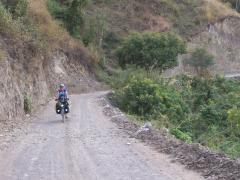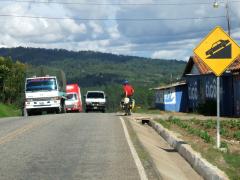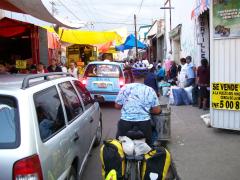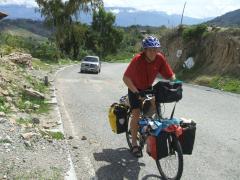Nancy's tips on riding the roads of Latin America
I wrote this in response to a letter of consternation from one of the few other women (and one of the very few other "mature" couples) riding a route like ours in Latin America. It seemed worth while sharing with you, my management technics on how I managed riding the roads of Latin America.
This intrepid rider sent a note saying that the roads of Mexico were freaking her out so she was hopping on buses to avoid certain stretches and was having a difference of opinion about the risk level of the roads with her husband. Here is my response, such as it is:
First of all, I do think you have great amount of courage and smarts and capabilities. I admire you on many accounts. Anyone that has ridden Copper Canyon the way you you did has my admiration. If I knew you better, I might be more comfortable telling you that you have balls.
In retrospect, after riding through Mexico, Guatemala, Honduras, Nicaragua, and Panama, my thoughts about riding in Mexico are that it is a difficult country to ride in, especially as you get closer to the cities. The bigger the city, the more aggressive the drivers, and less room for mistakes. That said, indeed, in order to keep yourself safe, one person in the group always has to be the most reasonable (usually the woman) to do what it takes to keep going safely and in one piece, both physically and mentally.
Here are some of my/our ways we keep going, keeping in mind I have more fear than Randy (or is it more sense?).

- I always use a helmet mirror, I can see 180 degrees behind me. It took me about ten days to get used to it. A few years latter I got Randy converted. At first we both used used a handlebar mirror but it is not good enough. With a helmet mirror or a mirror on the glasses, I can turn my head just a little bit and see completely in back of me. This is the number one thing that keeps me safe. Randy now rides 1000 times safer. He had many close calls that he was unaware of and therefore unable to take defensive action. So, you ask, what does it do for me? I can get off the road when there is just not enough room for all the traffic or I can take the whole lane when there is not enough room for the vehicle in back of me to pass or I can hear another vehicle is coming around a corner that the driver in back does not know about. I also walk sections that just do not make sense to ride, like blind corners up a steep mountain. Sometime I ride on the opposite side of the road where there is a better shoulder or no gutter. Mexico gutters suck. The roads in Guatemala, Honduras and Nicaragua do not have those steep gutter drop offs.
- A rule we try to follow with one or two exceptions, is the weakest link (usually me) gets to make the call. If one of has a concern we stop and discuss it and find a solution. One solution is to find a secondary road. We used a map of Mexico called Guia Roji which had yellow roads shown as secondary roads, we tried to ride mostly those. The ones with pavement but without painted lines were a great joy because of the light traffic and they brought us to places way out of the way which added increased interest for us. We always asked locals if there was alternative roads to get to where we wanted that where quite with less traffic. Most locals knew a different route. Also we use a GPS in many roads where on there but we relied on asking the locals.
- Another technique is when one of us gets freaked out by the traffic conditions or whatever, is to stop and regroup. During the rest we decide the best course of action, whether it is to find another route, just rest and regroup, use a different technique, or even take a bus. (We did take a bus because of traffic on one road in Costa Rica seemed deadly to me, but that's the only time we've actually done that. Not the only time we've taken a bus, but the first time we were forced off the road and into a bus by our perception of the highway and the traffic. That road from San Jose to Limón is just not for bikes. A few days after we attempted to ride it and bailed by hopping on to a bus, someone referred to it as the road of death)
- We do not separate -- except once when I was sick, I bused to the next town and got a hotel about 15 miles away. We stick together even though it means that one of us (Randy) probably won't get as far in a day, and both of us are affected by the other's riding style, of course. Randy rode many thousand of miles alone before we started this trip and he hated it. He was lonely and miserable. A key for us is to stay together and get to a safer place. Even though Randy hates to get rides and I respect that, we have a handful of times gotten rides when it just made more sense for various reasons. He use to be purist but he benefits more for taking an occasional ride. We stay together. One time we took a bus in Mexico was from Durango to Zacatecas - the vacation period of Semana Santa (Holy Week) was just coming up and it was reputed to be quite dangerous just as we were approaching a long (and probably quite boring) stretch of road.
- We wear real bright clothes when traffic is heavy. You know that green that screams I am really a yellow.
- When the traffic is intense, I feel better when Randy rides in back to give me a buffer, but not too close, so I can still see traffic in my mirror and I can take evasive action when required but not endanger him by my action. The one in back is given less room by the traffic then the one if front. By the time they pass me they have pulled into the other lane. Randy does not freak out but being the one in back as much as I do.
- As far as taking a bus ahead by yourself and letting your riding partner ride and catch up with you at the end of the day, You have to go by your gut. Every woman feels differently. For me, I found I have felt perfectly safe. I am 53 and not such a target as if I was much younger female. I do my business in the day and I do not go to big cities alone. If I feel strange vibrations, I usually go introduce myself by name and ask their name. It is the ones you do not see that our the problem. I ask for help if I need it and everyone is glad to help out and it give you a new adventure in making contact with the locals.
- One last thing - we have an agreement that any way that either of us wants to cope with the traffic or road safety is OK. In other words, there are no recriminations about "why did you get off the road - there was no problem" or "why are you afraid?" Each of us has a different experience at every moment, and we both have different fear and perception levels.
Do what you can to keep going. Take a break in a nice place for a period of time and them start again.
I hope I do not sound like I have all the answers because I do not. Every road is different. The Guatemala border crossing freaked me out because of the new experience of all the chicken buses coming up behind us. Boy are they aggressive but mostly with the loud horns. I thought they where saying "Watch out I am coming through and if you are in my way I am going to get you." But after a few days I found they really said, that they where coming though, yes, to give you warning but mostly to let the people know that their rides are coming or around corner to warn others of their presence and other times just to say hi, great job. They are very expressive with those horns. But they are good drivers and used to avoiding all sorts of things on the road, including cyclists. They don't get paid for having accidents or killing cyclists. I find that if everyone cooperates, including us, we all get along just great
Ok, I think I answered you question. Thanks for giving me a chance to run on at the mouth. You can tell we've talked and thought a lot about this. But our experience has been quite good.
Randy also wrote some notes on riding in Mexico, safety, maps, and route selection




